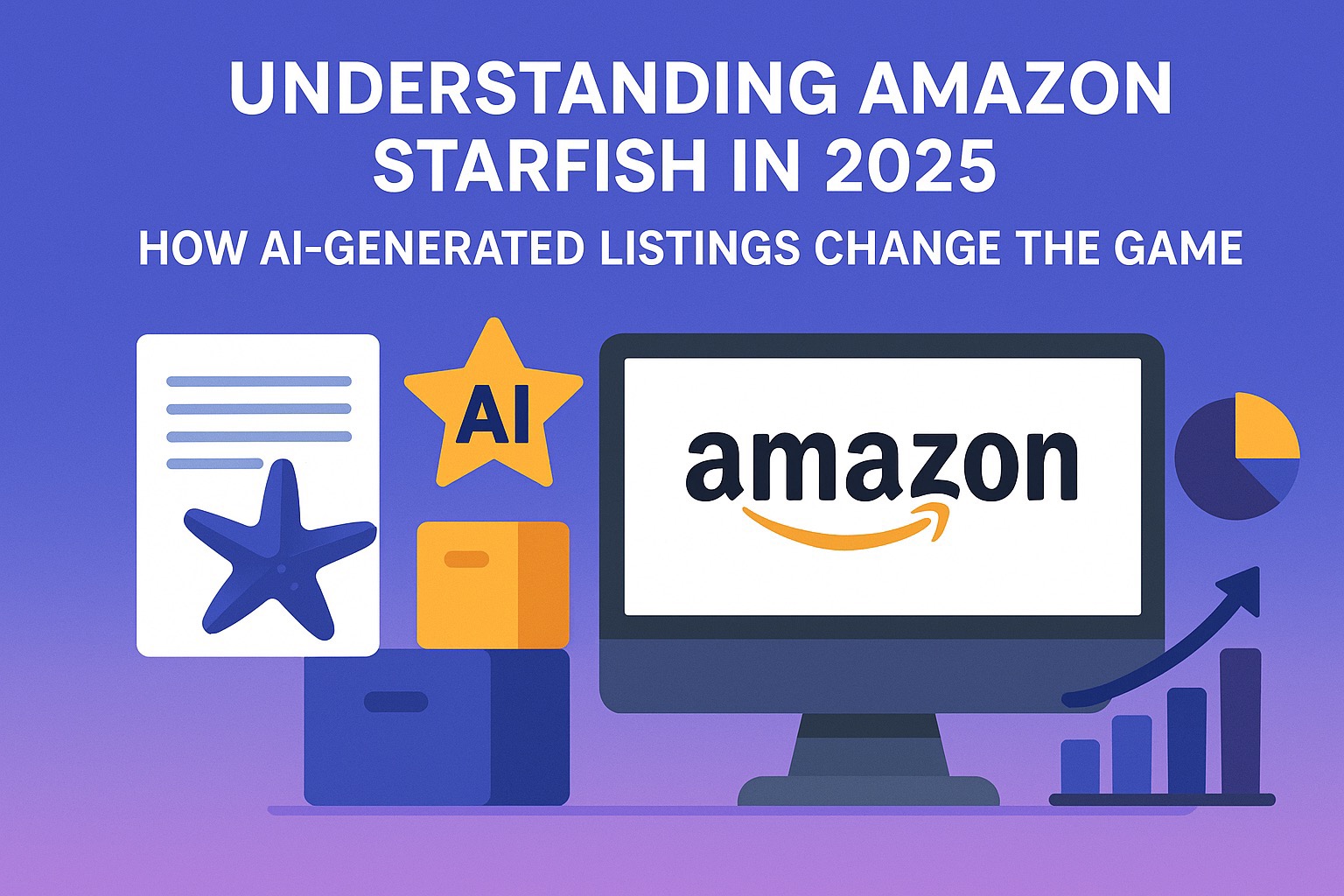Understanding Amazon Starfish in 2025: How AI-Generated Listings Change the Game
Amazon’s Project Starfish is one of the most disruptive initiatives in 2025 for third-party sellers. Designed to build a unified, AI-generated source of truth for product information, Starfish automates listing creation and content standardization at scale.
If you sell on Amazon, this affects you – directly.
In this article, we break down what Starfish is, why Amazon is doing this, and what you must change in your listing strategy to stay visible, compliant, and competitive.
What Is Amazon Starfish?
Starfish is an internal Amazon project using generative AI to auto-create product listings across the marketplace. It pulls data from:
- Product packaging
- Manufacturer websites
- Past listings
- Technical specs
- Public sources
The result: Amazon creates “canonical” listings – AI-generated product detail pages that it considers authoritative.
This isn’t a concept. It’s already rolled out across categories like electronics, personal care, home, and kitchen.
Why Amazon Launched Starfish
The project addresses major problems:
- Duplicate listings and redundant ASINs
- Low-quality seller-written content
- Inconsistent product data
- Customer confusion caused by variation listings and fragmented info
Starfish aims to:
- Provide one trusted version of every product’s listing
- Reduce dependence on sellers for listing copy
- Improve buyer confidence and conversion through consistency
What It Means for Your Listings
Related: Amazon Listing Optimization in 2025: Strategies That Actually Drive Conversions
Related: Possibility to Increase Amazon Sales With Targeted Listing Optimization
Here’s where it matters:
1. Your listing may be overwritten
- Amazon’s AI can replace your copy if it detects “higher confidence” data from packaging or official sources.
- Your bullets, title, and description can be suppressed or revised.
2. Brand voice and positioning may get erased
- Emotional hooks, use-case storytelling, and tone are not guaranteed to survive.
- You lose differentiation if your listing is reduced to tech specs.
3. Product detail pages are more regulated
- Sellers must now match the master content instead of editing freely.
- In some categories, you cannot override Starfish-generated titles or bullets unless brand registered.
What Starfish Does Well (and Poorly)
What it handles well:
- Technical details (dimensions, materials, certifications)
- Structured specs for comparison
- Factual consistency
Where it struggles:
- Unique brand angles or benefit-first phrasing
- Emotional context or audience-specific positioning
- Differentiation based on lifestyle or buyer psychology
If your listing depends on connecting with a specific kind of customer, Starfish listings may flatten your edge.
How to Protect and Adapt Your Listings
1. Register your brand (if you haven’t)
Brand Registry allows:
- Retaining custom titles and A+ content
- Suppressing automated changes in many cases
2. Strengthen A+ content and visual modules
Starfish may overwrite text, but A+ content remains your creative zone:
- Use lifestyle images
- Include use-case callouts
- Add comparison charts
This area is still seller-controlled and impactful.
3. Align your data with Amazon’s canonical structure
Ensure your:
- UPC / GTIN matches manufacturer data
- Product specs are accurate
- Packaging copy and product labeling are clean and compliant
Avoid being flagged as a low-trust data source.
4. Monitor listing changes with tools
Use SellerMax or similar tools to:
- Track when listing elements are changed by Amazon
- Get alerts when content is overwritten
- Compare before/after CTR and conversion
Strategic Opportunities Sellers Still Have
Amazon’s AI isn’t perfect. Sellers can still gain advantage by:
- Owning the narrative in A+ content and video
- Creating unique Amazon Posts tied to audience segments
- Writing compelling insert cards that guide customers to brand touchpoints
- Leveraging Q&A and review mining to reinforce positioning
AI-generated listings may be the default, but human-crafted positioning still closes the sale.
What This Means for Tools Like SellerMax
In a Starfish world, optimization shifts from keyword-first to differentiation-first.
SellerMax helps sellers:
- Identify where Starfish copy is underperforming
- Preserve emotional and benefit-based angles through alternative listing sections
- Track listing health and override triggers
Final Takeaway: Starfish Isn’t the End – It’s a Filter
Learn more about how we help sellers stay ahead of these changes at SellerMax.ai – Amazon Product Listing Optimization.
Amazon Starfish will automate baseline content.
But the listings that convert will still be:
- Strategically differentiated
- Buyer-centric
- Reinforced by visuals and customer language
If you want to stay competitive, shift your optimization from just writing copy to building defensible, persuasive listings around what Starfish can’t replicate: your unique customer angle.
CTA: Run a SellerMax listing audit to see which parts of your product page are vulnerable to replacement – and what you can strengthen now.
